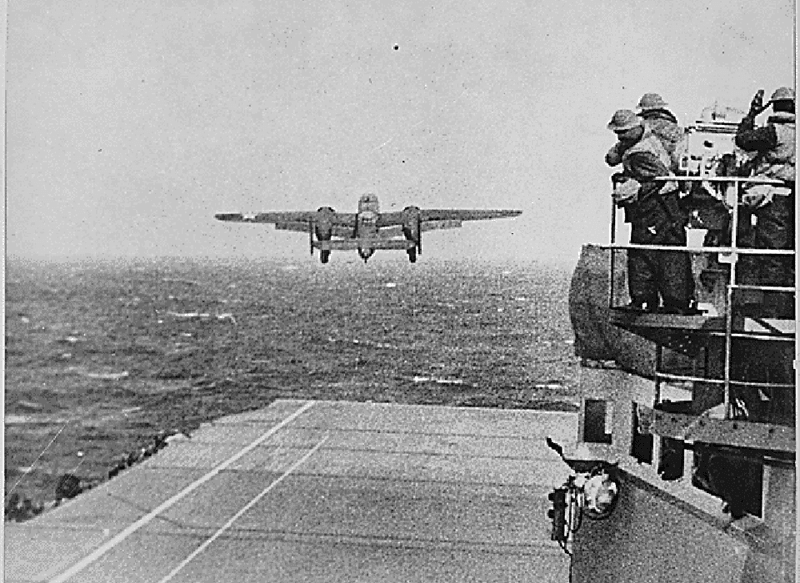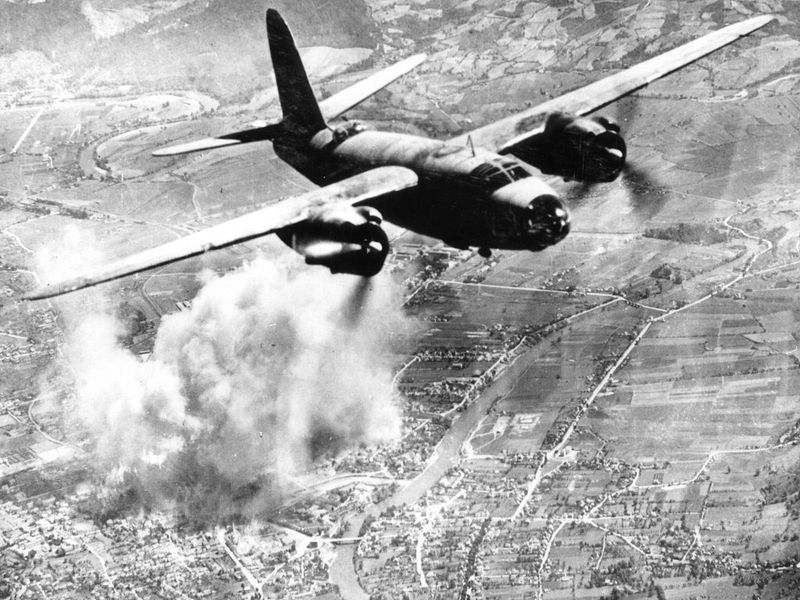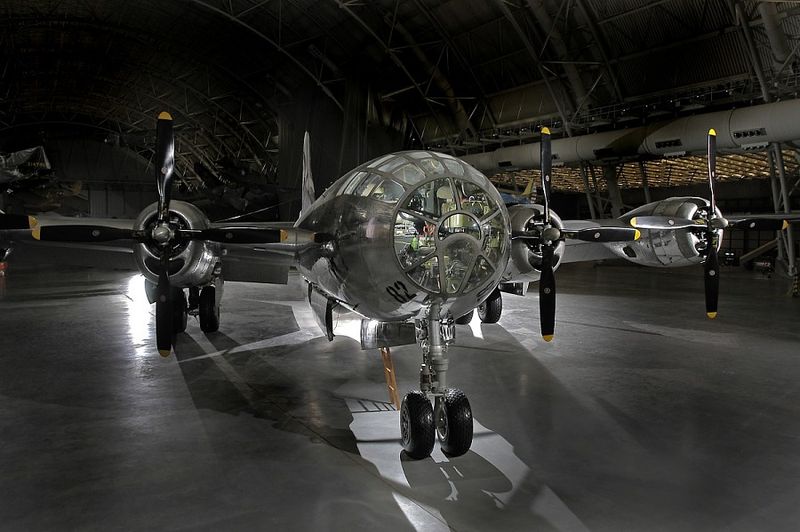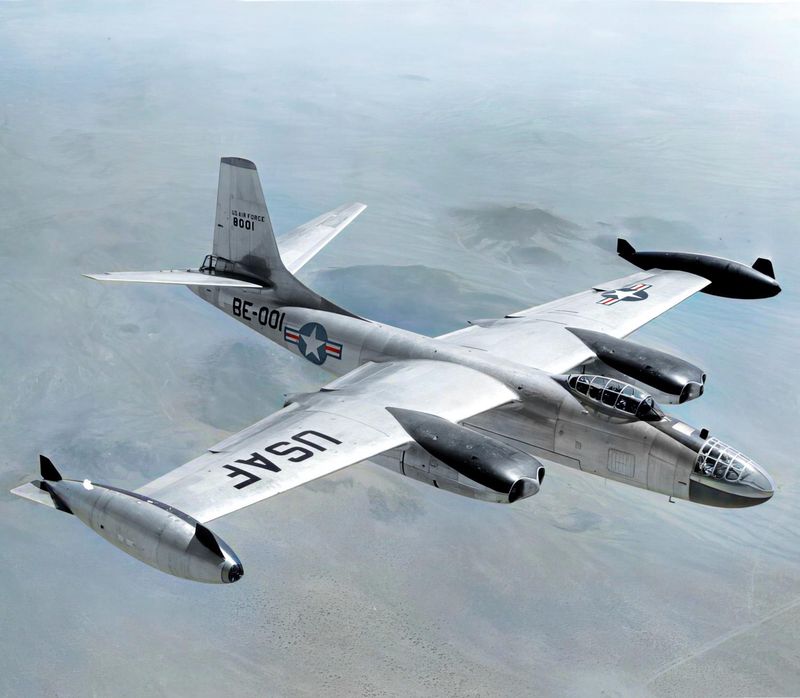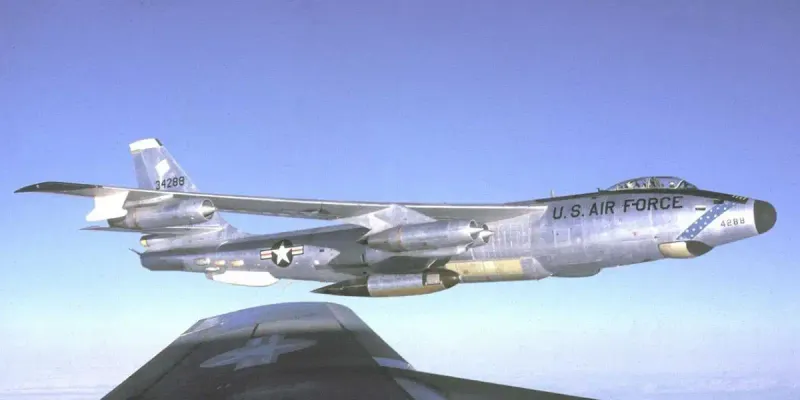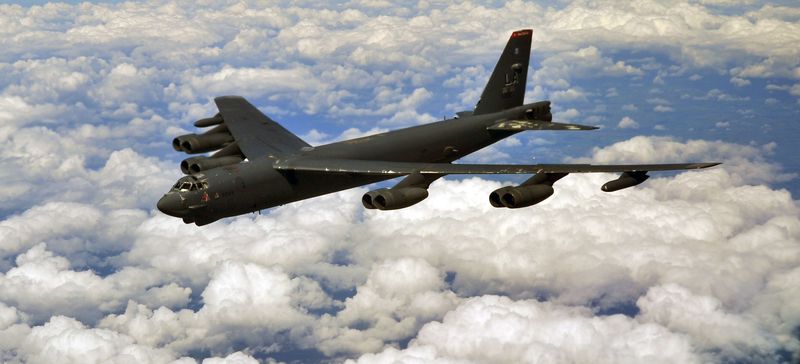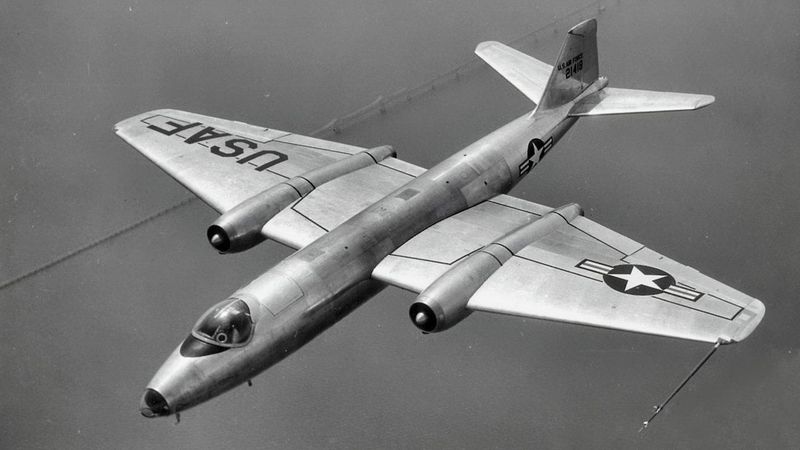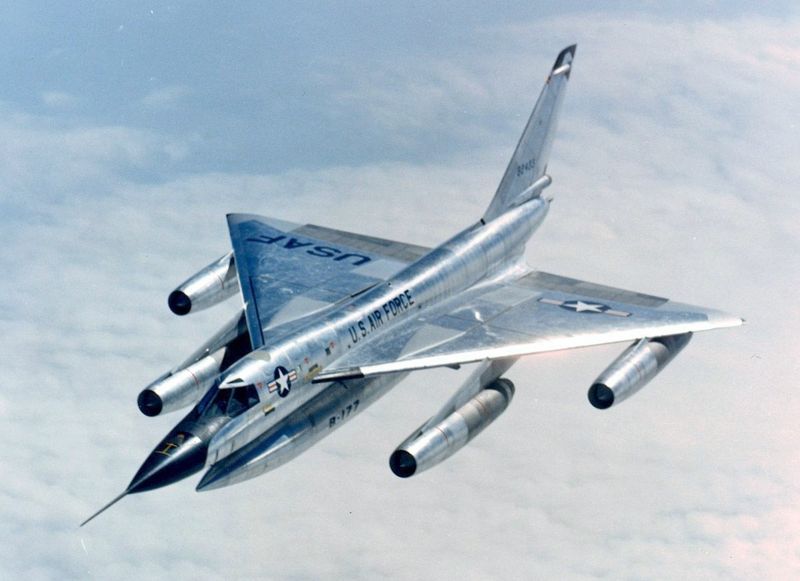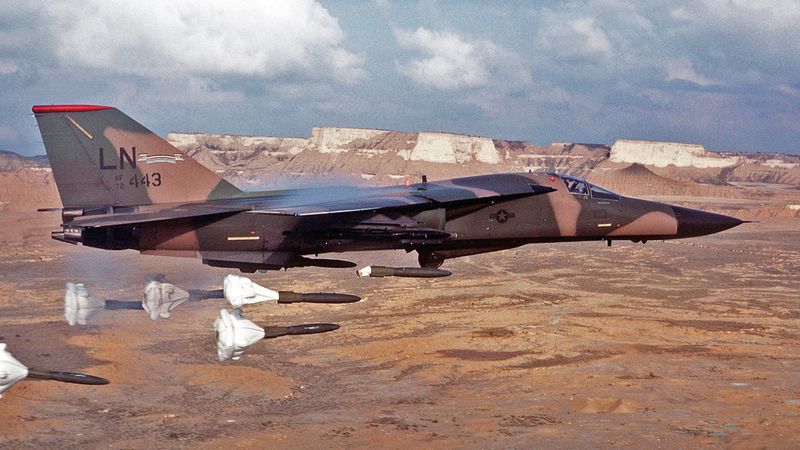The B-2 Spirit stealth bomber didn’t enter operational service until 1997, but for nearly nine decades the United States fielded a succession of bomb-carrying “B-planes” that shaped air warfare and nuclear deterrence. From World War II piston heavies to Cold-War Mach 2 jets, here are 15 U.S. bombers that paved the way for the B-2.
1. Boeing B-17 Flying Fortress (1938)
The B-17 Flying Fortress, with its robust design and formidable firepower, became an emblem of American air might during WWII. It flew predominantly in daylight raids over Nazi-occupied Europe. Its resilience under fire and vast payload capacity made it the backbone of the U.S. bombing campaign.
Pilots and crews lauded its ability to return home despite severe damage. This four-engine heavy bomber dropped more bombs than any other U.S. aircraft in the war.
Each mission was a testament to courage and engineering genius, earning the B-17 a revered place in aviation history.
2. Consolidated B-24 Liberator (1941)
The B-24 Liberator, history’s most-produced heavy bomber, served valiantly across every U.S. front. Its versatility saw it hunting U-boats in the Atlantic and flying perilous ‘Hump’ supply runs over the Himalayas.
Though less heralded than the B-17, the B-24’s contributions were immense. It boasted a longer range and larger payload, proving indispensable in various theaters.
Its distinctive twin tail and high aspect ratio wings made it a standout in the skies. Over 18,400 Liberators rolled off production lines, a testament to its vital role in securing Allied victory.
3. North American B-25 Mitchell (1941)
The B-25 Mitchell, a twin-engine medium bomber, etched its name in history with the daring Doolittle Raid. Sixteen B-25s launched from the USS Hornet to strike Tokyo, providing a morale boost for the U.S. early in WWII.
Its versatility saw it serve in various roles—from level bombing to anti-shipping strikes. The B-25 was adaptable, reliable, and beloved by its crews.
Famed for its robust build, it could take a beating and still bring its crew home. The Mitchell’s legacy is one of innovation and audacity in aerial combat.
4. Martin B-26 Marauder (1941)
Initially nicknamed the “Widowmaker” due to its demanding flight characteristics, the B-26 Marauder evolved to become one of WWII’s most successful bombers. Its sleek design enabled faster speeds than most contemporaries, offering a tactical advantage.
Despite early challenges, it achieved the lowest combat-loss rate of any Allied bomber in Europe. Crews grew to respect and trust its capabilities.
The Marauder’s transformation from a tricky aircraft to a reliable workhorse is a story of perseverance and adaptation. It remains celebrated for its role in crucial missions and its resilient nature.
5. Boeing B-29 Superfortress (1944)
The B-29 Superfortress, a marvel of engineering, brought futuristic capabilities to the WWII battlefield. Featuring pressurized cabins and remote-controlled turrets, it was ahead of its time.
Its most infamous role was dropping atomic bombs on Hiroshima and Nagasaki, hastening the end of the war. The Superfortress exemplified strategic bombing’s power and reach.
Pilots appreciated its long-range capabilities and innovative technology. The B-29 set a new standard for heavy bombers, leaving an indelible mark on history and ushering in the atomic age with both awe and controversy.
6. Consolidated B-32 Dominator (1945)
The lesser-known B-32 Dominator served as a backup to the B-29 Superfortress, stepping in during the final days of WWII. Though it saw limited action, its contributions were noteworthy.
It flew the last American combat sorties, including the final air battle which claimed the last U.S. air-combat fatality of the war. The B-32’s service was brief but critical.
With robust defensive armament and advanced engineering, it represented a commitment to air superiority. The Dominator’s legacy is one of a capable understudy ready to take the stage when called upon.
7. Convair B-36 Peacemaker (1949)
The B-36 Peacemaker, with its titanic 230-ft wingspan, was a true giant of the skies. As the first intercontinental nuclear bomber for the U.S. Air Force, it symbolized American strategic power during the early Cold War.
Its distinctive six pusher propellers and later four jet engines gave it a unique profile. The Peacemaker could fly missions spanning continents, a feat unparalleled at the time.
Though it never saw combat, the B-36’s role in deterrence was vital. It remains a testament to Cold War engineering and America’s aerial might.
8. North American B-45 Tornado (1948)
The B-45 Tornado, America’s first operational jet bomber, marked a new era of aerial warfare. Its sleek design and jet propulsion offered a leap in speed and performance.
During the Korean War, it served in reconnaissance and bombing roles, proving its versatility. The B-45 also made history as the first multi-engine jet to refuel in flight.
Though it had a short service life, its impact was lasting. The Tornado’s technological advancements paved the way for future jet bombers, underlining its role as a pioneering force in aviation history.
9. Boeing B-47 Stratojet (1951)
The B-47 Stratojet, with its sleek, swept-wing design and six turbojet engines, was a marvel of Cold War technology. It bridged the gap between WWII heavies and modern jets.
Flying at speeds over 600 mph, the B-47 was pivotal to U.S. strategic air command. By 1956, it formed 28 SAC wings, a backbone of early Cold-War deterrence.
Its introduction marked a seismic shift in bomber design, setting the standard for jet-powered flight. The Stratojet’s legacy is one of innovation and strategic importance in the nuclear age.
10. Boeing B-50 Superfortress (1948)
The B-50 Superfortress, an advanced derivative of the B-29, was equipped with more powerful engines and structural enhancements. It achieved fame with the Lucky Lady II’s 1949 non-stop global circumnavigation, highlighting aerial refueling’s potential.
This feat demonstrated unprecedented global reach for the U.S. Air Force. The B-50 played key roles in reconnaissance and weather missions during its service.
Its innovations in range and capability underscored the growing importance of strategic bombing. The Superfortress remains a symbol of post-war ingenuity and ambition in aviation.
11. Boeing B-52 Stratofortress (1955)
The B-52 Stratofortress, a stalwart of the U.S. Air Force, first took to the skies in 1955 and remains in service today. Known for its versatility, it has carried both nuclear and conventional ordnance.
It has participated in every major U.S. conflict from Vietnam to the Middle East. Its endurance and adaptability are unmatched in aviation history.
With over 70 years of service, the B-52 is slated to continue flying past 2050. Its longevity and reliability make it a true icon of air power and innovation.
12. Martin B-57 Canberra (1953)
Adapted from Britain’s Canberra, the B-57 became a versatile asset for the U.S. Air Force. It excelled as a night intruder and close-air-support jet during the Vietnam War.
Later, it transitioned to high-altitude reconnaissance and weather missions. The B-57’s adaptability ensured its relevance across diverse roles throughout its service life.
Its dual role as both a combat and intelligence platform showcased its multifaceted capabilities. The Canberra’s legacy is one of versatility, proving indispensable in both warfare and peacetime operations.
13. Convair B-58 Hustler (1960)
The B-58 Hustler, the world’s first operational Mach 2 bomber, was a revolutionary force in aviation. It carried a single large nuclear weapon in a detachable pod, pushing speed and altitude boundaries.
Setting numerous records, the Hustler’s sleek design and performance were unparalleled. Despite its early retirement in 1970, its impact was profound.
The B-58’s advanced technology paved the way for future high-speed bombers, leaving a legacy of innovation and daring. It remains a symbol of Cold War era ingenuity and ambition.
14. General Dynamics FB-111A Aardvark (1967)
The FB-111A Aardvark, a swing-wing descendant of the F-111, brought new capabilities to SAC. Its ability to hug terrain at supersonic speed made it a formidable nuclear deterrent.
Designed for low-level penetration, it could deliver nuclear payloads deep within enemy territory. Its versatility and advanced avionics were key to its effectiveness.
Though it was eventually phased out, the Aardvark’s contributions to strategic bombing were significant. It remains a testament to Cold War innovation and tactical prowess.
15. Rockwell B-1B Lancer (1986)
With variable-sweep wings and advanced radar-evading tactics, the B-1B Lancer redefined strategic bombing. It replaced some roles of the B-52, bringing new capabilities to the U.S. air arsenal.
The B-1B flew its first combat missions in 1998’s Operation Desert Fox, showcasing its precision and power. In Operation Enduring Freedom, it delivered 40 percent of the bomb tonnage in the opening months.
Its adaptability and modern design have ensured its place in current and future operations. The Lancer remains a crucial component of America’s strategic air power.



